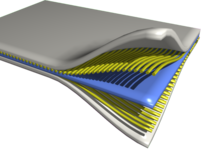
Back مادة مؤلفة Arabic Kompozit material Azerbaijani Композитен материал Bulgarian Compòsit Catalan Kompozitní materiál Czech Defnydd cyfansawdd Welsh Komposit Danish Verbundwerkstoff German Kompozita materialo Esperanto Material compuesto Spanish
It has been suggested that this article should be split into articles titled Autoclave moulding, Resin transfer moulding, Pressure bag moulding and Light resin transfer moulding. (discuss) (November 2020) |


A composite material (also called a composition material or shortened to composite, which is the common name) is a material which is produced from two or more constituent materials.[1] These constituent materials have notably dissimilar chemical or physical properties and are merged to create a material with properties unlike the individual elements. Within the finished structure, the individual elements remain separate and distinct, distinguishing composites from mixtures and solid solutions. Composite materials with more than one distinct layer are called composite laminates.
Typical engineered composite materials include:
- Reinforced concrete and masonry
- Composite wood such as plywood
- Reinforced plastics, such as fibre-reinforced polymer or fiberglass
- Ceramic matrix composites (composite ceramic and metal matrices)
- Metal matrix composites[2]
- and other advanced composite materials
There are various reasons where new material can be favoured. Typical examples include materials which are less expensive, lighter, stronger or more durable when compared with common materials, as well as composite materials inspired from animals and natural sources with low carbon footprint.[3]
More recently researchers have also begun to actively include sensing, actuation, computation, and communication into composites,[4] which are known as robotic materials.[5]
Composite materials are generally used for buildings, bridges, and structures such as boat hulls, swimming pool panels, racing car bodies, shower stalls, bathtubs, storage tanks, imitation granite, and cultured marble sinks and countertops.[6][7] They are also being increasingly used in general automotive applications.[8]
The most advanced examples perform routinely on spacecraft and aircraft in demanding environments.
- ^ "What are Composites". Discover Composites. Archived from the original on 2021-05-22. Retrieved 2020-12-18.
- ^ Zhou, M. Y., et al. "Progress in research on hybrid metal matrix composites." Journal of Alloys and Compounds 838 (2020): 155274.
- ^ Nepal, Dhriti; Kang, Saewon; Adstedt, Katarina M.; Kanhaiya, Krishan; Bockstaller, Michael R.; Brinson, L. Catherine; Buehler, Markus J.; Coveney, Peter V.; Dayal, Kaushik; El-Awady, Jaafar A.; Henderson, Luke C.; Kaplan, David L.; Keten, Sinan; Kotov, Nicholas A.; Schatz, George C. (2022-11-28). "Hierarchically structured bioinspired nanocomposites". Nature Materials. 22 (1): 18–35. doi:10.1038/s41563-022-01384-1. ISSN 1476-1122. PMID 36446962. S2CID 254094123. Archived from the original on 2022-12-12. Retrieved 2022-12-12.
- ^ McEvoy, M. A.; Correll, N. (19 March 2015). "Materials that couple sensing, actuation, computation, and communication". Science. 347 (6228): 1261689. doi:10.1126/science.1261689. PMID 25792332.
- ^ "Autonomous Materials Will Let Future Robots Change Color And Shift Shape". popsci.com. 20 March 2015. Archived from the original on 27 September 2017. Retrieved 3 May 2018.
- ^ "Composites | Composite Materials". Mar-Bal, Inc. 2013-10-15. Archived from the original on 2015-11-13. Retrieved 2020-12-18.
- ^ "Applications | Composites UK". compositesuk.co.uk. Archived from the original on 2015-02-26. Retrieved 2020-12-18.
- ^ "Achieving Class A Appearance On Fiber-Reinforced Substrates". www.coatingstech-digital.org. Archived from the original on 2021-09-20. Retrieved 2021-06-24.